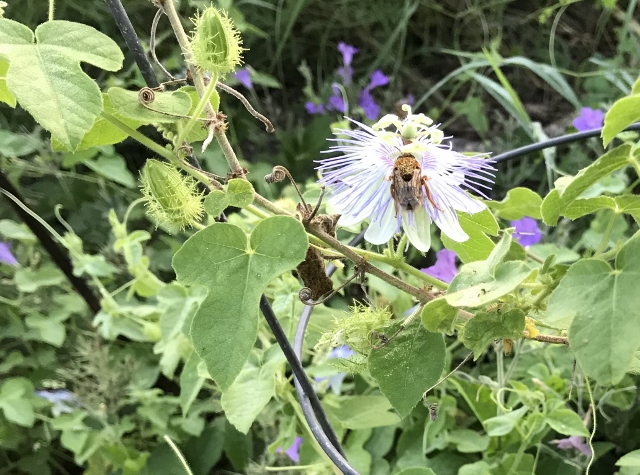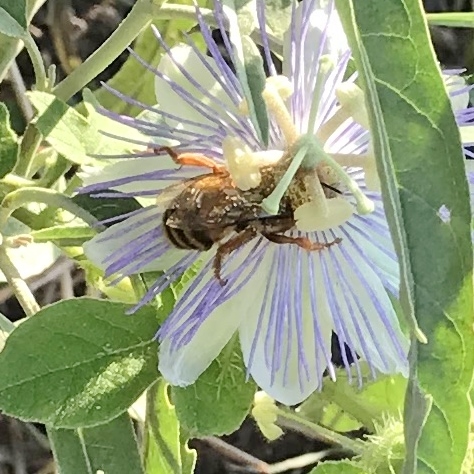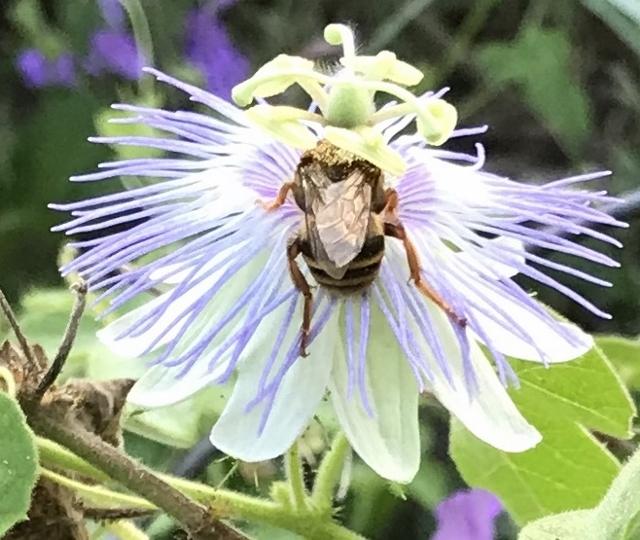August was dreadfully hot. Drought- and heat-stressed ash trees are nearly bare, their leaves dropping like a late Midwest autumn — the only good to come of their dead leaves is the addition of carbon to the compost piles and nitrogen for the grass.
Just when the horizon — and the habitat — looked its most dismal, our traditional September rains have come — quick downpours between eerily-lighted skies that cast psychedelic hues onto the landscape greenery.
One morning, a pink sky was busy with hundreds of dragonflies and swallows in a seemingly choreographed swirl as they captured unseen bugs and mosquitoes in their mid-air dance.
Even before the rains, regeneration was quietly all around, as if the plants knew the glorious rains were on their way.
As scorching and breathless as August was, as parched and seared as the landscape looked, our native plants continued to thrive, growing, blooming, going to seed — providing nectar and pollen and protein along the way — like the delicate-seeming but hearty Passiflora foetida, Corona de Cristo, a passion vine that had popped up in my vegetable garden in early summer. I gave it a tomato-cage-jungle-gym to play on.

This particular vine was prominent in an AgriLife pollinator project I joined this summer. Briefly, the project documents where the pollinators are during one-minute observations at various times of the day.
Surrounding this Passiflora foetida vine, are pigeon berry, skeleton leaf golden eye, lantana camera, eyebane, ruellia and tomatoes. I only had a hand in planting the tomatoes. All the native plants arrived on their own (from other parts of the yard) and established themselves near the fence at the back of the vegetable garden.
The honeybees, without fail, have visited only the passion vine ignoring all the other offerings. The AgriLife team will have to explain that phenomena after they tally and study the summer’s uploaded citizen science observations from Texas and Oklahoma.


Another summer project I accidently took on was improvements to my nectar gardens. In late July, I was thinking ahead to September and October and the annual butterfly convergence. I jumped the gun and bought a couple of flowering trees and three flowering shrubs, thinking I’d tend them like they were being cared for at the nursery until the cooler, tree-planting months.
Well, August crept in and my old mantra wouldn’t let me alone — plants do so much better planted in the ground — only trouble was, all my new plants required full sun — and it was August, probably the worst month ever to plant anything.
I felt so sorry for the plants, imagining how hot their roots were getting in their confined containers that I planted them all in the brutal month of August. I don’t recommend this, but here’s what I did. I dug way-big holes, and filled them with water two or three times for a couple of days. Then I filled the holes with buckets-full of homemade compost mixed in with the excavated soil. Again, I watered the holes.
After about the third day of watering the soil in the holes, I planted the two trees and three shrubs very early in the morning and watered them in quite well. I stuck iron bars in the ground and configured cardboard and sheets in ways that would shield the new plants from the harshest afternoon sun. I watered the plants every day — in the morning and in the evening, and sometimes in the afternoon if they looked really pitiful. The plants that were blooming when I purchased and planted them lost their blooms. The leaves were wilted-looking each evening.
Why I watered them so much was because of a snippet of information I remembered from my Texas Master Naturalist classes some five years ago. We learned that plants receive nutrients from the soil, but that the roots can only absorb the nutrients via water. — Please, any of you biologists, do elaborate or correct that concept if I’ve misspoken.
Fortunately, my story has a happy ending. The September rains came, the temps cooled by about eight degrees, and the blooms have come back. I have a 100 percent success rate with these five plants. It cost me a lot of extra work during the hottest month of the year but the anticipation for an exciting butterfly season is worth the effort.
Above, I mentioned mixing homemade compost with the soil before planting my new plants. If you haven’t tried your hand at making compost, it’s rather a fun venture, easier than you think and not time consuming, once you’ve constructed the initial pile.
Briefly, here’s the recipe for making compost: air, water, greens (nitrogen) and browns (carbon).
Aim for a ratio of two buckets greens to three buckets brown. A good size for a compost pile is three to five feet long, three feet tall, three feet deep. If it begins to smell, add more carbon ingredients.
Turn the pile about once a week. Water is important to the decaying process. A flat-topped pile will collect water better than a mounded pile. In the summer, in the Valley, you can have compost in about 18 days if the pile is in full sun, has been watered and turned. In the winter, it may take about a month.
Greens (nitrogen): fresh grass clippings, fruits and vegetables, kitchen scraps, eggs and egg shells, coffee grounds and filters, tea bags, green leaves and plants.
Browns (carbon): fallen leaves, dried grass clippings, sawdust, shredded newspaper, paper and junk mail, cardboard rolls, paper towels, straw/hay, old potting soil, stale spices.
These don’t go in a compost pile: Bones, dog/cat waste (potential parasites), grease, fat, oil, ash, meat, fish, dairy, invasive or diseased plants, weed seeds.
As usual, the Internet is full of information about composting — why you would want it, how to make it, more allowable ingredients, how and where to use the end product.
Here’s a printer-friendly in-depth information guide from AgriLife:
https://cdn-ext.agnet.tamu.edu/wp-content/uploads/2017/06/composting-for-a-garden.pdf
Another good pdf is here:
http://takecareoftexas.org/sites/default/files/publications/gi-036.pdf